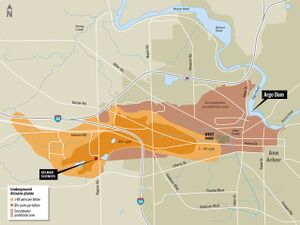Gelman dioxane plume (nonfiction)

The Gelman dioxane plume (or Gelman plume) is a groundwater plume of 1,4-Dioxane spreading through the Ann Arbor, Michigan area, moving east through the city's west side toward West Park and branches of the Allen Creek drain system that discharge to the Huron River.
Mitigation
Gelman Sciences is removing water from the ground using extraction wells and then treating it to remove dioxane. Treated water with lower levels of dioxane is then discharged to Honey Creek, which flows to the Huron River upstream of Barton Pond, Ann Arbor's main municipal water supply.
Dioxane
1,4-Dioxane (or simply dioxane) is a heterocyclic organic compound, classified as an ether. It is a colorless liquid with a faint sweet odor similar to that of diethyl ether. The compound is often called simply dioxane because the other dioxane isomers (1,2- and 1,3-) are rarely encountered.
Dioxane is used as a solvent for a variety of practical applications as well as in the laboratory, and also as a stabilizer for the transport of chlorinated hydrocarbons in aluminum containers.
Dioxane has affected groundwater supplies in several areas. Dioxane at the level of 1 μg/L (~1 ppb) has been detected in many locations in the US. In the State of New Hampshire alone in 2010 it had been found at 67 sites, ranging in concentration from 2 ppb to over 11,000 ppb. Thirty of these sites are solid waste landfills, most of which have been closed for years. It also has low toxicity to aquatic life and can be biodegraded via a number of pathways. The problems are exacerbated since dioxane is highly soluble in water, does not readily bind to soils, and readily leaches to groundwater. It is also resistant to naturally occurring biodegradation processes. Due to these properties, a dioxane plume can be larger (and further downgradient) than the associated solvent plume.
- 1,4 Dioxane @ Wikipedia
Commentary
JeffreyHayner
On the Boing Boing bulletin board, user JeffreyHayner states:
Meanwhile, down the road a little ways in Ann Arbor, the city council is trying to balance the books on the backs of the water users by shifting all sorts of funds to the Water and Sewer fund, including Forestry and a public art skim. In the above chart we are #400, but that is just water charges. We also pay ever-growing (4%increase /year for last 3 years) sanitary sewer and storm water fees. What is shown as an average annual bill of $238 is really closer to $600.
The city continues to refuse to take direct action on our own toxic mess, the Gelman Plume of 1,4 dioxane that has been creeping towards the river for 30 years. We have already closed source wells and private wells in the prohibition zone. Our most recent “leadership” on the issue has been for city council to “urge” by resolution the MDEQ to look into the issue, and lower the allowable amount of dioxane from 85 ppb to 3.5 ppb. When it does reach the river, the plan is to connect to Detroit Water so we too can pay more.
For an excellent example of data imagining by a concerned citizen check out this site: Scio Residents for Safe Water, headed by local hero Roger Rayle. To give you an idea of the size of both the fresh water flowing in our region, and the poisons it contains, under MDEQ oversight Gelman/Pall are extracting and treating at a rate of 500 gals/minute and predict it will take several hundred years to finish. So, risk-management is the MDEQ word of the day. There is no intention to clean it, at all.
- Comment by (February 24, 2016)
Links
Internal
External
- Superfund option for Gelman plume back on Ann Arbor council’s agenda - January 3, 2020
- Ann Arbor considering worst-case scenario for Gelman dioxane plume - Updated May 31, 2019; Posted May 30, 2019
- [Jeff Irwin (politician)] @ Wikipedia - In 2016, Irwin spearheaded reducing of the DEQ threshold for dioxane from 85ppm to 7.2ppm, with emergency promulgation, following the discovery of a family affected by numerous health conditions, found drinking and living with well water with high levels of dioxane. He also organized a DEQ Townhall on dioxane in Ann Arbor, bringing together experts like Roger Rayle, who had been tracking the spread of dioxane in the area for decades, precipitating the EPA SuperFund application by Washtenaw County (although in opposition of the City of Ann Arbor, whose mayor, Chris Taylor, who was concerned that real estate values would drop with SuperFund designation.)